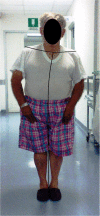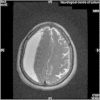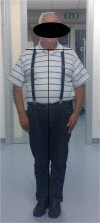Reversible Pisa syndrome associated to subdural haematoma: case-report
- PMID: 25123109
- PMCID: PMC4236656
- DOI: 10.1186/1471-2377-14-149
Reversible Pisa syndrome associated to subdural haematoma: case-report
Abstract
Background: Pisa Syndrome or Pleurothotonus is a relatively rare truncal dystonia, characterized by tonic flexion of the trunk and head to one side with slight rotation of the body. Since frequently associated to specific drugs such as antipsychotics and cholinesterase inhibitors or to Parkinson Disease, a pathophysiological role of cholinergic-dopaminergic imbalance has been suggested. We report here the first case of Pisa Syndrome due to an extracerebral pathology as subdural haematoma.
Case presentation: A hypertensive patient was admitted to Our Department for subacute onset of tonic flexion and slight rotation of the trunk associated to progressive motor deficit in left upper limb after a mild head trauma without loss of consciousness occurred around three month before. No previous or current pharmacological interventions with antidepressant, neuroleptic or anticholinergic drugs were anamnestically retrieved. Familiar and personal history was negative for neurological disorders other than acute cerebrovascular diseases. Acutely performed cerebral MRI with DWI showed a voluminous right subdural haematoma with mild shift of median line. After surgical evacuation, both motor deficit and truncal dystonia were dramatically resolved. At one-year follow up, the patient did not develop any extrapyramidal and cognitive signs or symptoms.
Conclusions: According to many Authors, the occurrence of truncal dystonia during several pharmacologic treatments and neurodegenerative disorders (such as Alzheimer disease and parkinsonian syndromes) supported the hypothesis that a complex dysregulation of multiple neurotransmitter systems are involved. We suggest a possible role of basal ganglia compression in pathogenesis of truncal dystonia by means of thalamo-cortical trait functional disruption and loss of proprioceptive integration. A further contribution of the subcortical structure displacement that alters motor cortex connectivity to basal ganglia may be postulated.
Figures



References
-
- Ekbom K, Lindholm H, Ljungberg L. New dystonic syndrome associated with butyrophenone therapy. Z Neurol. 1972;202:94–103. - PubMed
Publication types
MeSH terms
LinkOut - more resources
Full Text Sources
Other Literature Sources
Medical

